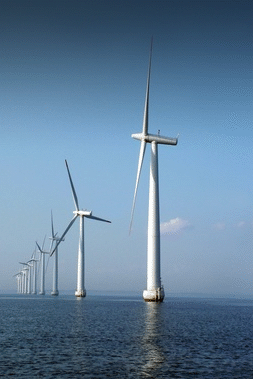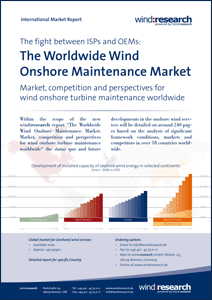The Worldwide Wind Onshore Maintenance Market
Market, competition and perspectives for wind onshore turbine maintenance worldwide
The current study shows – based on the current and future developments in all significant countries – the markets, trends and potentials of the onshore wind services.
The status quo of onshore wind services – essentially based on the installed capacities, the political development objectives and the legal, economic and social environment of the respective states – assumes a high market dynamic in the future. Regarding the competition the OEMs try to defend their market shares against ISPs, which are acquiring more and more know-how and therefore try to chase contracts and experts. But there is also still the possibility of “make” instead of “buy”: operators, who take care of the major part of the services; built up capacities and try to optimize their assets.
Due to the recent tender results, for example in Germany onshore down to 2,2 ct/kWh (offshore 0,0 ct/ kWh), the market participants are forced to further reduce costs, in all parts of the value chain. Technical developments are foremost in relation with turbines and tower foundations. Opportunities arise in some countries especially in the „following” onshore wind service market. These chances are perceived by both independent service providers and manufacturers, who compete heavily in an onshore wind market segment. The study is based on the status quo, which shows a rather high future capacity (GW) in Canada, South America and Asia while the European market is nearly exhausted in terms of siting. In the past decade the global onshore wind market was growing enormously – from a total capacity of 91 GW in 2007 to 539 GW in 2018. Whilst growing, the global market still becomes difficult to assess regarding different and changing country specific framework conditions. North America has different support schemes for wind power with an average part of 24 percent onshore wind in the renewable energy mix. South America holds the most auction systems to support wind power with an average of 16 percent onshore wind in the renewable energy mix. Europe forces “Feed-in-tariffs” and auction systems to strengthen wind power; the actual amount of onshore wind in the renewable energy mix reaches up to 38 percent. In Asia, a feed-in-tariff system is still the dominating support scheme – with auction systems consistently increasing. Onshore wind represents 23% in the renewable energy mix.
The maintenance sector of the current global onshore wind market offers different opportunities, but also holds risks for manufacturers, service providers (maintenance support suppliers, who are working for manufacturers and operators [MSSs] and independent service providers [ISPs]) and operators. Stating an outlook for the wind onshore maintenance market, wind:research included several key drivers in its analysis. Using the methodology of desk- and field-research, wind:research heeded upcoming auction systems, market consolidation, pricing of turbine services, global market changes and staff topics amongst others, to predict the market development precisely.
The fight between ISPs and OEMs
Within the scope of the new wind:research report “The Worldwide Wind Onshore Maintenance Market. Market, competition and perspectives for wind onshore turbine maintenance worldwide“ the status quo and future developments in the onshore wind services will be detailed on around 120 pages and 100 pages (Profiles) based on the analysis of significant framework conditions, markets and competitors in over 18 countries worldwide.


